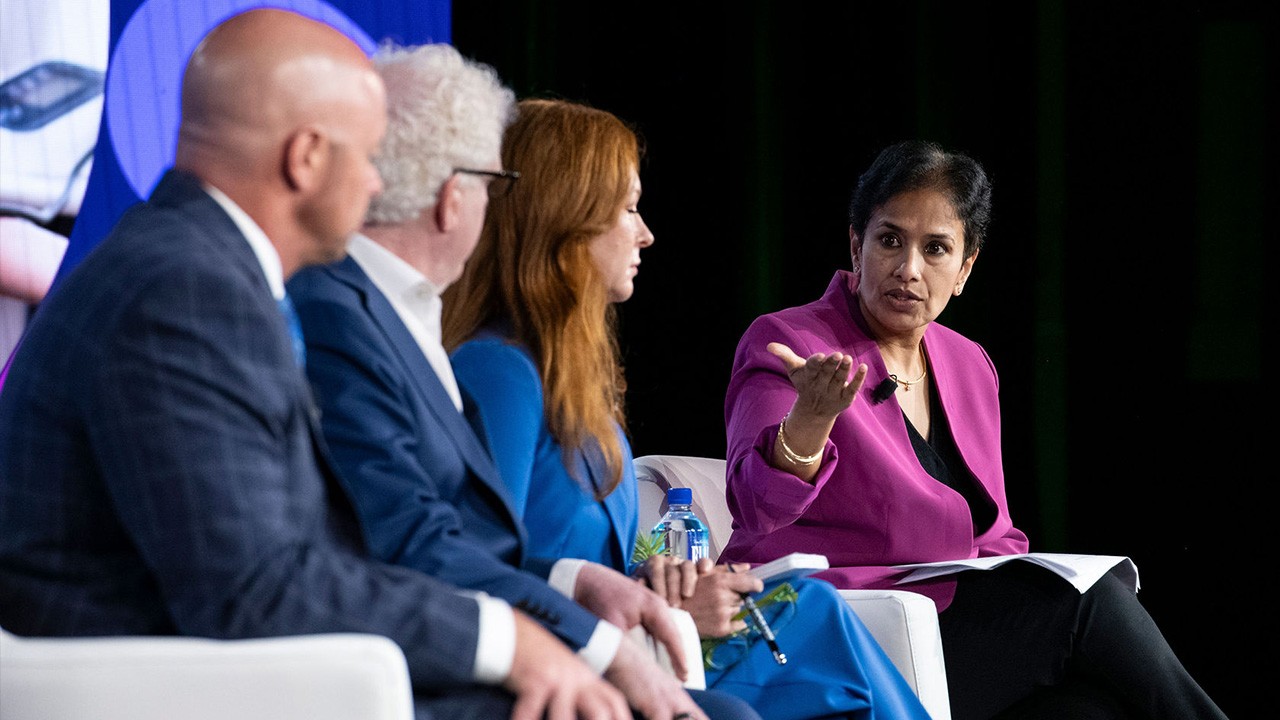

Responsible decisions in the rapidly evolving world of GLP-1s
Shealynn Buck, MD, Chief Medical Officer, Lockton
Robert Gabbay, MD, PhD, FACP, Chief Scientific and Medical Officer, American Diabetes Association
Timothy Law, DO, MBA, Chief Medical Officer
Vidya Raman-Tangella, Chief Medical Officer, Teladoc Health
Session: Understanding the New Breakthroughs in Weight Loss and Diabetes Care
Since GLP-1s for weight loss emerged about a year ago, there continues to be breakthroughs in our clinical understanding. As care models change, Dr. Vidya Raman-Tangella said organizations continue to try and do the right thing for their populations.
“There’s obesity, cardiometabolic health, comorbidities and serious illness,” Raman-Tangella said. “What they all have in common is their association with weight and the accompanying molecular- and cellular-level changes.”
Our understanding of weight and obesity has changed a lot over 20 years, from body weight being connected simply to the amount of calories consumed to a deeper understanding of the combination and timing of carbohydrates, proteins and fats.
“The science is always evolving. We know more today than we did a year ago, and we will know more a year from now.”
For guidance, organizations should turn to clinicians about balancing safe, effective coverage and costs. At Forum 2024, clinical leaders gave their perspective on the evolving world of GLP-1s and how they’re helping organizations navigate it.
Given the effectiveness of GLP-1s in supporting weight loss and reducing the risk of cardiovascular diseases, these medications have revolutionized care, Dr. Robert Gabbay said. Effectiveness and a U.S. population in which more than 50% of people could be clinically eligible has led to unprecedented demand.
Organizations concerned about the financial impact of such demand are often criticized as only caring about cost, Dr. Shaelynn Buck said. “What they care about is their people,” she said. “They just want to make responsible decisions.” Buck and other Lockton health experts work with employers to address their healthcare challenges.
Complicating things for organizations is emerging real-world evidence for the use of GLP-1s for weight loss. Results show the importance of ensuring the right patients for therapy and the value of a comprehensive approach.
As many as 60% of patients stop taking the medication within a year. “That’s a sunk cost, because they regain the weight,” Buck said.
At Teladoc Health, the focus is a better understanding of why people stop taking a GLP-1 for weight loss and why responses differ. “We’re in a position to not only track at a macro level but also to understand at a granular level who’s responding and why,” Dr. Raman-Tangella said. “We’re looking at the data so we can do better ourselves and be in a position to work with others.” She said Teladoc Health is particularly focused on results for underrepresented populations and ensuring social drivers and other barriers don’t prevent people who want the drug from getting it.
But there’s still a lot to learn from real-world evidence. “Until we really get to the bottom of why people are stopping so quickly, we need to be more diligent about how we can help doctors pick the right patient,” Dr. Timothy Law said.
For people on the drug, access to lifestyle programs that include mental health are critical to optimizing the medication. “What we know about these drugs is that no one size fits all.” Raman-Tangella said, “They should only be used as complementary to lifestyle management.”
Buck recommends a comprehensive, whole-person approach, because people often have multiple chronic conditions.
“Teladoc Health was at the forefront of moving from managing a disease to supporting the individual that has this condition and all the other conditions they have with it,” Buck said. Addressing food security and behavior change is important for obesity prevention and management, she said.
As it relates to food and behavior, Gabbay sees the focus changing from quantity, which GLP-1s help address, to food quality. “That’s going to be a big shift, whether it’s more protein because of muscle wasting or just reinforcing the value of lifestyle,” he said. “And then exercise. If you could have a drug that was as powerful as exercise, it would be the biggest blockbuster ever.”
Mental health support is also important because of the impact GLP-1s can have. “You can’t expect someone to go from being a 45 BMI to a 25 BMI, and then look in the mirror one day and see a different person,” Law said. “Who’s helping them through that? Because that’s how you end up back where you were because you didn’t recognize the person you see in the mirror.”
High costs and access issues have clinical leaders concerned with companies presenting compounded GLP-1 products as a lower-cost option. Buck said the fear is companies interfering with the provider-patient relationship. With concerns about the safety of compounded GLP-1s, the American Diabetes Association is leaning in to protect the public from companies who prescribe without understanding the whole patient.
The challenge for organizations is getting and staying ahead. Gabbay suggested watching for new potential advantages of GLP-1s, including treatment for kidney disease and sleep apnea, and a pipeline with more than 20 new drugs in clinical trials. If a subset of those drugs becomes available, the hope is that it will help addresses costs, he said.
Buck hopes that decisions are made with the understanding that obesity is a disease. “The future is beyond BMI,” she said. “Obesity needs to be addressed like the complex condition that it is and in a comprehensive, holistic way with an interdisciplinary approach that it deserves.”
As the GLP-1 landscape evolves daily, organizations still have to make decisions,” Raman-Tangella said. “If there’s one thing we can do, it’s band together and share our insights,” she said. “So that together we can create a care model that address quality, safety, access and costs.”









